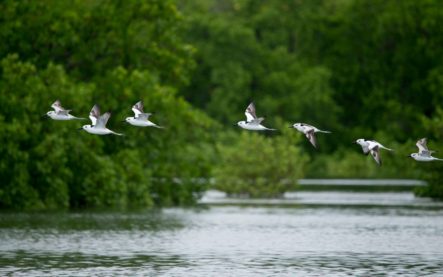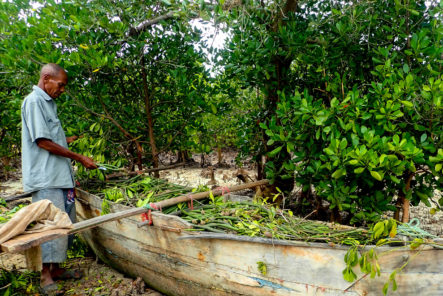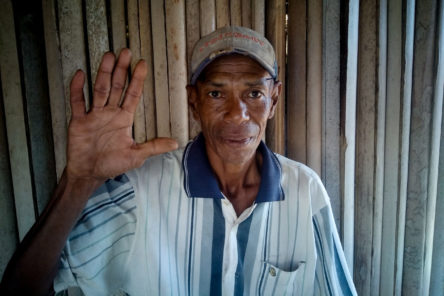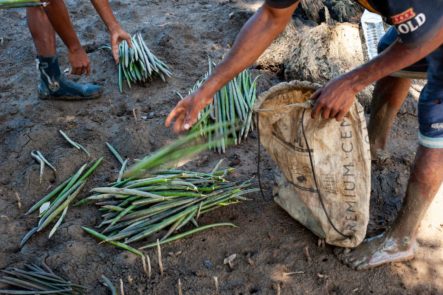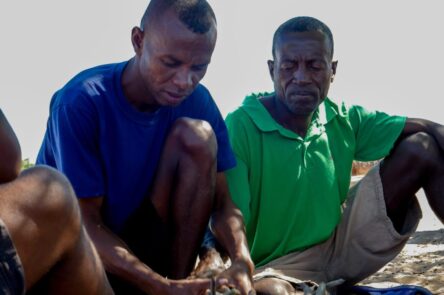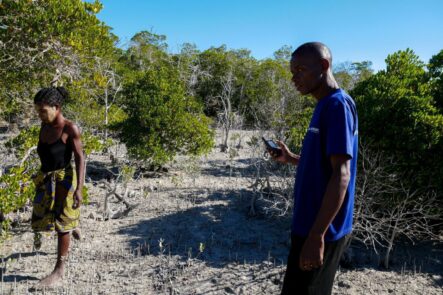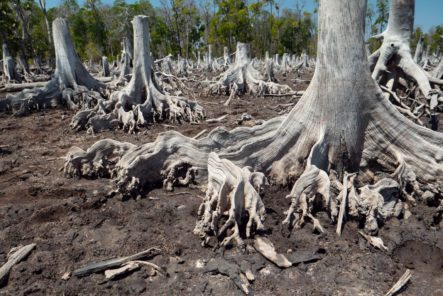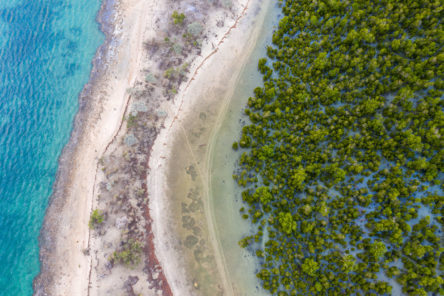This post is also available in:
 French
French  Malagasy
Malagasy
In celebration of International Day for the Conservation of the Mangrove Ecosystem on Sunday 26th July, our team in Madagascar spoke to colleagues and community members who live and work amongst the mangrove forests.
We asked them about their favourite mangrove-dwelling creatures, their most unforgettable experiences in the mangroves, and their more somber reflections of working with these incredible but vulnerable forests. We also found out what they think the mangroves would say if they could talk…
Clovice Boto
Blue Forests Technician, Mahajamba Bay, northwest Madagascar
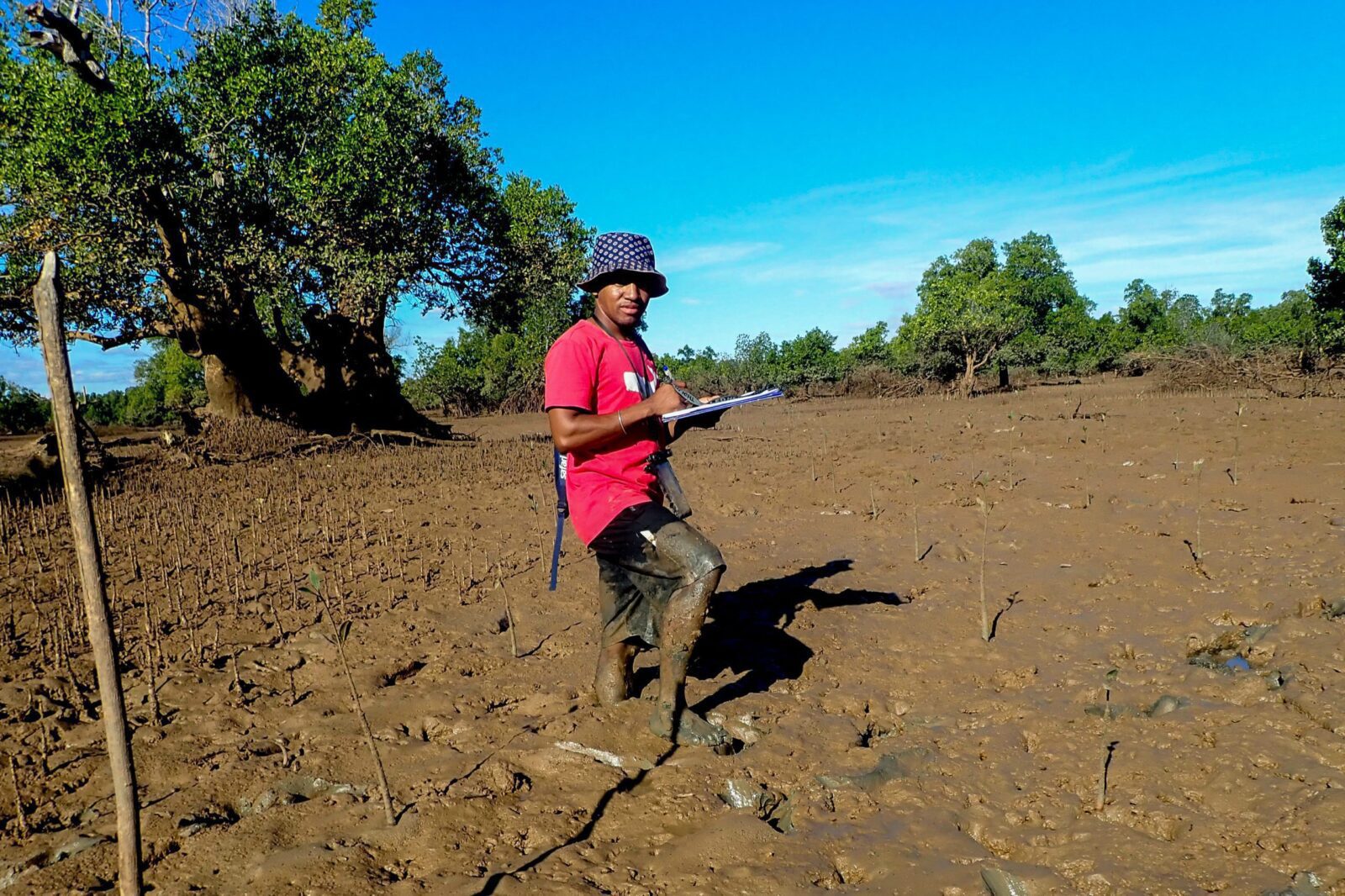
Clovice hard at work in the muddy mangroves
My name is Clovice Boto. I live in Besakoa, northwest Madagascar, in Mahajamba Bay and I am a technician for Blue Ventures’ Blue Forests programme.
In the Antrema Protected Area, I take part in the inventory and monitoring of the mangroves, which means assessing the level of deforestation, before monitoring both illegal logging activity and replanting efforts. I also participate in the monitoring of mangrove plantations carried out by the fishers’ association of the village of Boanamary with the support of Blue Ventures’ partner, GIZ, via the Environmental Management Support Programme (PAGE). In order to increase community understanding of the importance of preserving mangroves, I teach environmental awareness in five schools in Mahajanga, the capital of the region.
Among the many animals that live in the mangrove forests, my favourites are the birds. I never tire of admiring them and observing their behaviour as they glide through the air over the mangrove forests.
My greatest memory of the mangroves is when a huge number of community members gathered in Antangena, a village in Mahajamba Bay, for a mangrove reforestation day. Together, we planted hundreds of new propagules (mangrove seeds) – I still remember the joy I felt and the warm atmosphere of an entire community working together to protect their environment.
However, my saddest moment in the mangrove is the reason we have to organise reforestation days in the first place; it’s always hard to see cut mangroves trees and the overexploitation of the natural resources of the mangrove (including the trees themselves, as well as the animals and fish) as it leads to the chronic poverty of coastal communities in Madagascar.
I think that if the mangroves could speak, they would say:
That’s enough. Protect us. Protect the habitats of your marine resources because we are ready to provide you with what you need.”
Rabenoely
Fisherman and Vice President of the locally managed marine area (LMMA) association Tambatra, Mahajamba Bay, northwest Madagascar
My name is Rabenoely, but everyone calls me Baban’i Bolida. I live in the village of Antangena, in Mahajamba Bay. I am a fisherman and Vice President of the Tambatra fishers’ association, which was established with the support of Blue Ventures.
As a volunteer, I raise awareness and teach people in my community, as well as members of our fishers’ association, about the importance of protecting our mangrove forests. I also regularly participate in community mangrove reforestation activities.
The fishing eagle, known as Ankoay in Malagasy, is the species I admire the most in the mangroves. He has a power and strength that allows him to live and reign in the places where he soars.
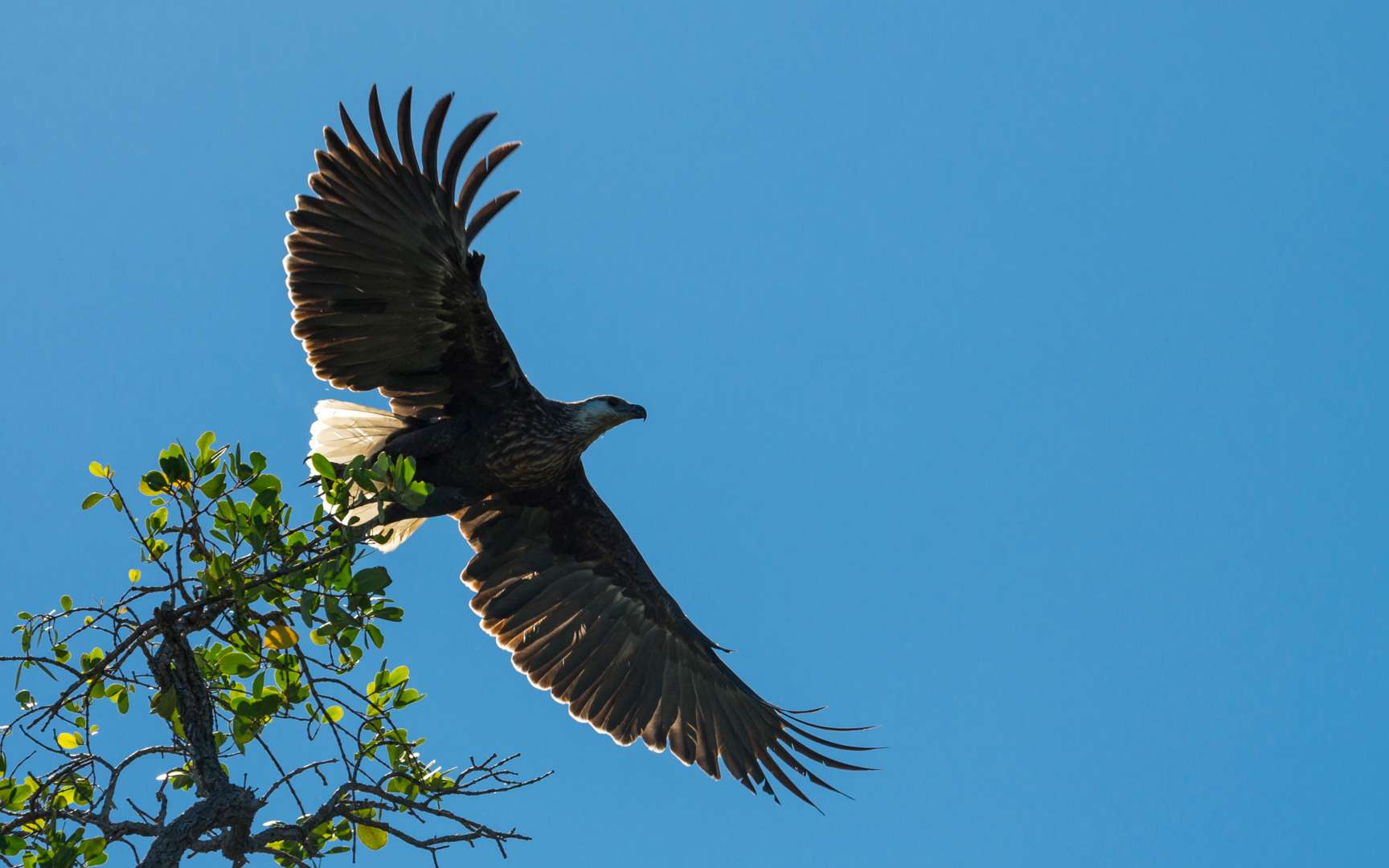
A Madagascar fish eagle takes flight in Ankatafa, Ambanja | Photo: Louise Jasper
When I am in the mangroves, I love it when the trees are submerged by the ocean at high tide. The air is purified and it gives me a feeling of freedom. When I fish at high tide, I feel like I’m in paradise.
There is also a special event that I remember: 150 community members from my small village learned how to reforest the mangrove, collected the propagules and worked together to replant the mangroves of Tambatra.
I feel sad when I see that some people are still unaware of the importance of mangrove forests, the lack of commitment from some authorities, and the death of mangroves due to erosion and illegal cutting.
I think that if the mangroves could speak, they would say:
Help, help, protect us.”
Giamalidiny Jaofary
Mangrove Reforestation & Education Assistant Officer, Tsimipaika Bay, northwest Madagascar
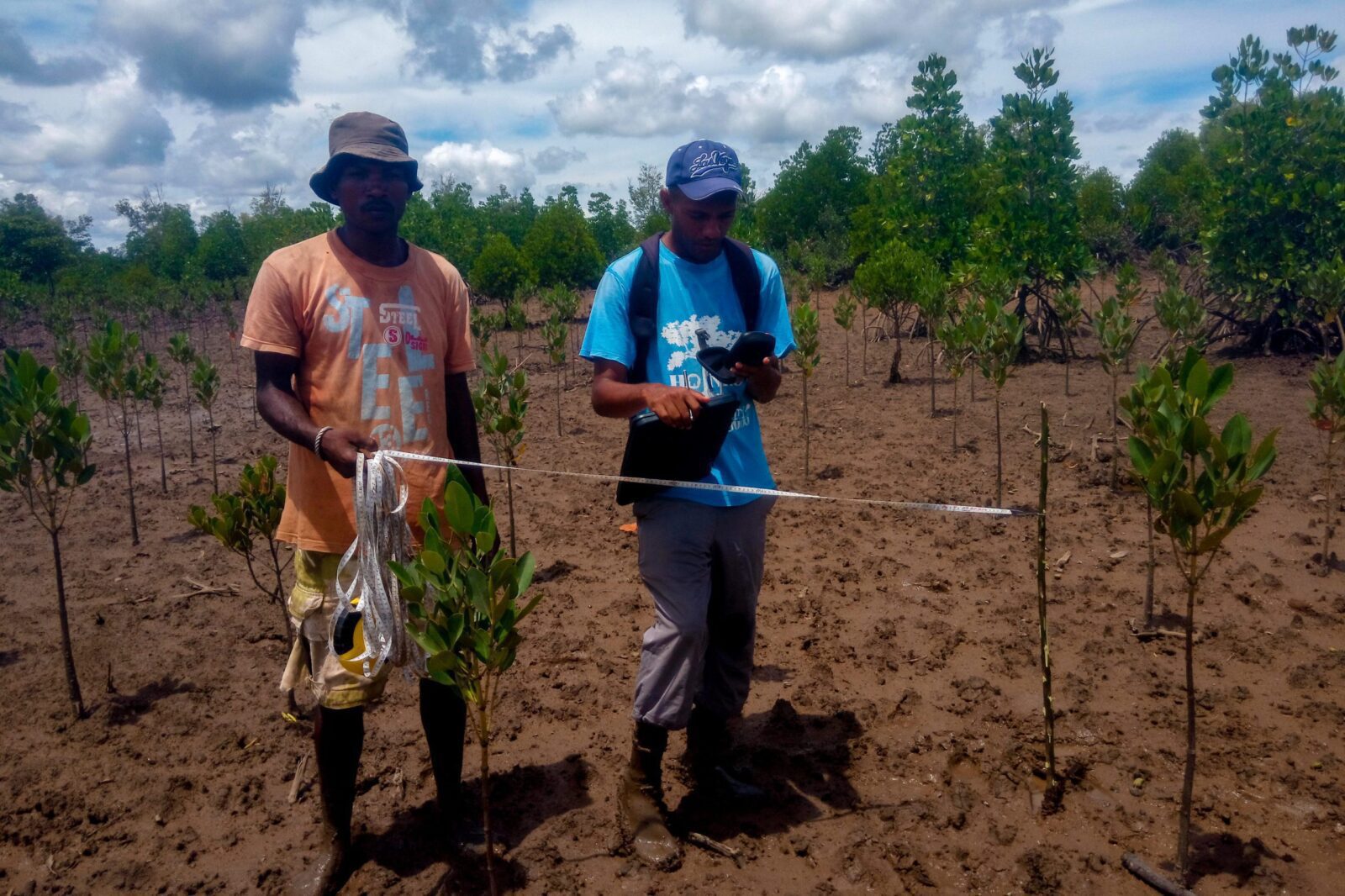
Giamali (right) monitoring the progress of replanted mangroves
My name is Giamalidiny Jaofary. I provide technical support for the reforestation of mangroves within the Blue Ventures team based in Ambanja, in the northwest of Madagascar.
I work to protect the mangrove forest in three ways: I speak to community members about the importance of mangrove protection; I train them in mangrove reforestation techniques; and I monitor the plants in order to evaluate the survival rate and, if necessary, schedule additional replanting.
My favourite creatures in the mangroves are mangrove crabs. They are edible, so they provide the protein we need, as well as a source of income for coastal communities. I am also always so impressed by their ability to bury themselves in the mud!
One day, with a community leader, we went to collect GPS points in the mangrove, and we got lost in the forest all day long. We returned home tired and mosquito-bitten, but peaceful and happy after an entire day spent in these amazing forests!
My saddest memory is when I discovered that the mangroves planted by community members in the village of Maropamba had been cut down. Unfortunately, cutting mangroves is often the last resort for people who have no alternative income opportunities.
If the mangroves could speak, they would say:
We don’t understand the behavior of human beings. They are destroying us, but if we are preserved, we can offer them food security, a healthy environment, and a source of income. Protect us if you want to have a better life!”
Evariste
Deputy President of the community association of Andimakafito, Mahajamba Bay, northwest Madagascar
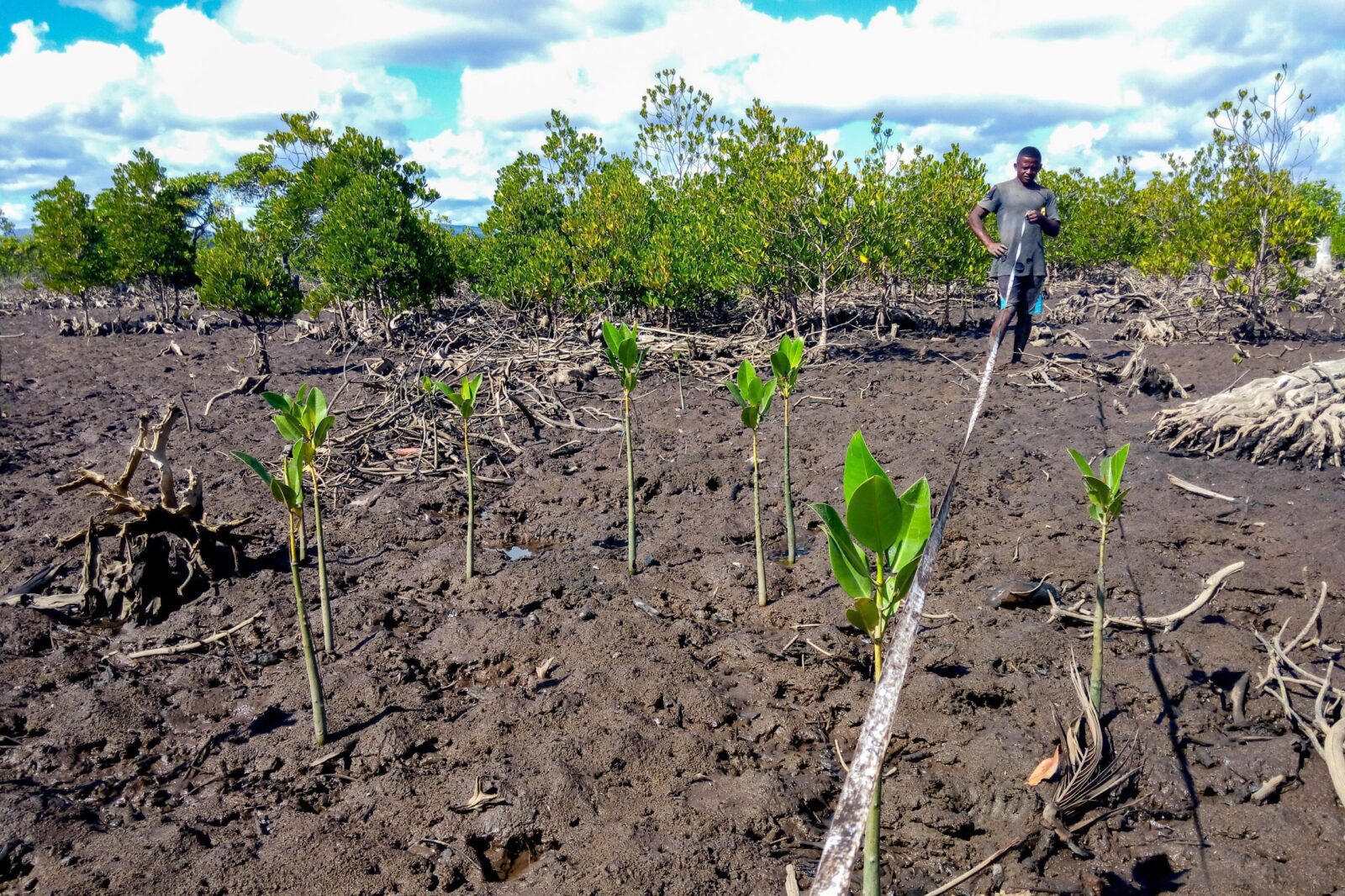
Evariste evaluates mangrove growth after replanting
My name is Evariste, I live in the village of Andimakafito, in the bay of Tsimipaika, northwest Madagascar. I am deputy to the President of the community association that ensures the local management of the mangrove. I am also a community leader for mangrove reforestation.
To protect the mangroves, I work with community members and members of the community association on mangrove reforestation, and monitor the reforestation efforts.
My favourite memory of the mangroves was a long time ago, when the mangrove forests were not yet destroyed. It was so easy to find the wood we needed to build our houses, and we didn’t have to go very far to find mud crabs for food. But over time, the mangroves became degraded, and the crabs and fish were much harder to catch. Today, it makes me happy to see that with community reforestation efforts, life in the mangroves is slowly coming back to how it used to be.
I think that if the mangroves could speak to us, they’d say:
Do not destroy us. When we are alive, we can ensure your wellbeing, and protect your shores from the flooding of your fields and villages.”
Aina Celestin
Blue Forests Community Liaison Officer, Bay of Assassins, southwest Madagascar
My name is Aina Celestin. I live in Andavadoaka, southwest Madagascar. The village where I grew up is surrounded by beautiful mangrove forests, but throughout my life, I’ve seen our forests slowly shrink. I was born in the village and I feel it is my duty to protect them. After years of work as a terrestrial forest patroller in Mikea National Park – between Toliara and Morombe in southwest Madagascar – I joined Blue Ventures to support Tahiry Honko, the world’s largest community-led mangrove carbon conservation project.
In my role as Blue Forests Community Liaison Officer, I work on the Tahiry Honko project by supporting the communities in their reforestation efforts. I also helped to establish the community monitoring and evaluation committee in the area.
Over the years, I have had many experiences in the mangroves, but one of the most fantastic field experiences I have had was the discovery of the fruitbat species Pterofus rufus in the mangroves around my village. It is both a bird and a mammal, and is endemic to my country. I felt so proud and happy to discover that these bats live in the mangroves of our area, as it shows their incredible biodiversity.
If the mangroves could talk, I think that they would say:
We deserve rights like human beings. We need to be cared for, respected and left in peace. It is from here that we can grow, produce and provide the sustainable goods and services you need for your own survival”
Ms. Alphine
Fisherwoman and member of the mangrove community surveillance patrol, Bay of Assassins, southwest Madagascar

Ms. Alphine inspects a cut mangrove tree whilst on patrol
My name is Alphine. I come from Lamboara, a small village in the heart of the Bay of Assassins. To earn a living, I fish for octopus and grow red seaweed. In 2017, I joined the community committee for the surveillance and monitoring of the mangroves as my village is involved in the Tahiry Honko project. Apart from my regular patrolling responsibilities, I have also participated in the development of local regulations for mangrove management.
There are many fascinating creatures living in the mangroves, but shrimp are my favourite; they are as easy to fish as crabs, and provide both food and a source of income.
My favourite memory in the mangrove is the first time I went on patrol. It wasn’t easy, but it was motivating and exciting. I feel sad that there are still people who cut down the mangroves, so I am happy to be working to protect them.
If the mangroves could speak, I think they would ask us:
We provide you with food and clean air, why are you cutting us down?”
To learn more about Tahiry Honko, watch our new film:



